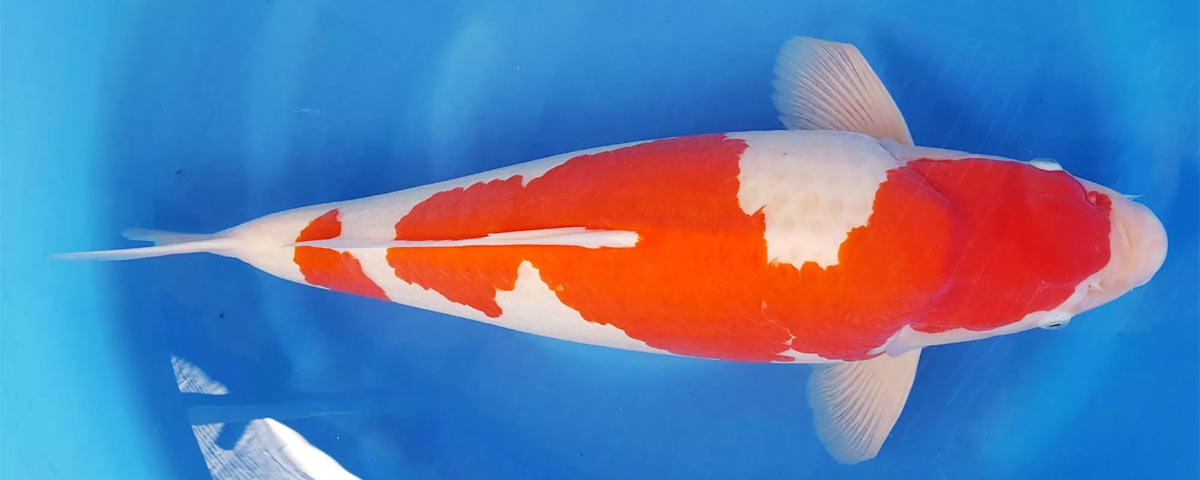When you mention the word ‘koi’ to most people, the first image that usually comes to mind is a red and white koi, or a Kohaku. The Kohaku is the quintessential koi and one of the ‘Big Three’ koi varieties (Kohaku, Sanke & Showa). It has combination of deep red patches that form a pleasing pattern over a pure white body. A high quality Kohaku is truly stunning when fully grown.

Since koi were originally cultivated for their value as food fish, it wasn’t until chance genetic mutations produced colourful variations that the aesthetic potential of these fish began to be realized. The earliest records of coloured carp date back to the 18th century when rice farmers in the Niigata Prefecture noticed some of these carp developed unique colours. Some of these farmers started setting these carp aside and selectively breeding them, leading to the first rudimentary forms of ornamental koi. Among these early varieties, red and white patterned koi, which would later be known as Kohaku, began to emerge.
The late 19th century marked the beginning for the Kohaku variety. Sometime in the 1880s, a koi named “Kojaku” was born, featuring a distinct red and white pattern. This fish is widely considered the prototype of the modern Kohaku variety. Selective breeding with this koi improved the colour and pattern of the offspring with each successive generation, eventually leading them to focus specifically on enhancing the red (hi) patterns and the pristine white (shiro) background and the balance between the two.
Over the years, they Japanese koi breeders have honed their techniques to produce fish with increasingly refined patterns and colours. Breeders aim for well-defined, symmetrical red markings that contrast sharply against ‘snow-white’ skin. Classic patterns such as “Nidan” (two-step) and “Sandan” (three-step) are highly prized, with the fish’s beauty judged on the symmetry and placement of these patterns.
Since its’ early beginings, the Kohaku has always a favouorite. Today it is the most popular variety of koi with koi breeders and collectors in Japan, and around the world today. If you are ever lucky enough to attend a koi show in Japan, most of the fish entered in the competition would be Kohaku. Although there are koi varieties with more colours and more intricate patterns, the simplicity of the red and white pattern of the Kohaku continues to call to koi enthusiasts.
It can’t be stressed enough that the white (shiro) should be pure bright white and free from blemishes. Ideally, the red markings (hi) should be deep in colour and uniform shade with the edges of the pattern well defined. We refer to the placement of the hi on the shiro of the body as a pattern. The red pattern may be distributed in many different ways, but as a general rule, the hi should cover about half of the body and should be well balanced throughout the body, both left and right, and front to back.
Below you can see some of the more common Kohaku patterns that are produced by breeders.
Below you will see a video of some beautiful nisai (2 year old) Kohaku.
Below you will find the descriptions, terminology and phrases commonly used to describe Kohaku koi.
Aka – (AH kah) Red
Aka hana – (AH kah HAH nah) Red nose
Bozu – (boh ZOO) No hi on the head, bald head
Ginrin or Gin-Rin – (geen reen) Refers to sparkling scales
Godan kohaku – (GOH dahn koh HAH koo) a 5-step Kohaku pattern
Hachi – (HAH chee) Head
Hara – (hah RAH) Abdominal area
Hi – (HEE) A term for red
Inazuma – (EE nah ZOO mah) Lighting strike pattern
Ippon hi – (EE pohn HEE) A continuous red pattern from head to tail
Kohaku – (koh HAH koo) A koi with a white body and red markings
Kuchibeni – (KOO chee BEN eee) Red lips
Maruten – (MOH roo ten) A separate, self contained hi (red) pattern on the head with other hi patterns on the body
Menkaburi – (MEHN kah BOO ree) Hi (red) covering the entire face or head
Motoaka – (MOH toh AH kah) Red markings at the base of the pectoral fins
Nidan Kohaku – (nee DAHN koh HAH koo) A 2-step Kohaku
Odome – (oh DOH meh) Last marking before the tail
Ojime – (oh GEE meh) Gap between the last pattern marking and the tail
Sandan Kohaku– (SAHN dahn koh HAH koo) A 3-Step Kohaku
Shiro – (SHEE roh) White
Tancho – (TAHN choh) A koi with a single hi (red) spot on the head only
Yondan Kohaku – (YAHN dahn koh HAH koo) A 4-Step Kohaku
Back to our Koi Varieties Guide